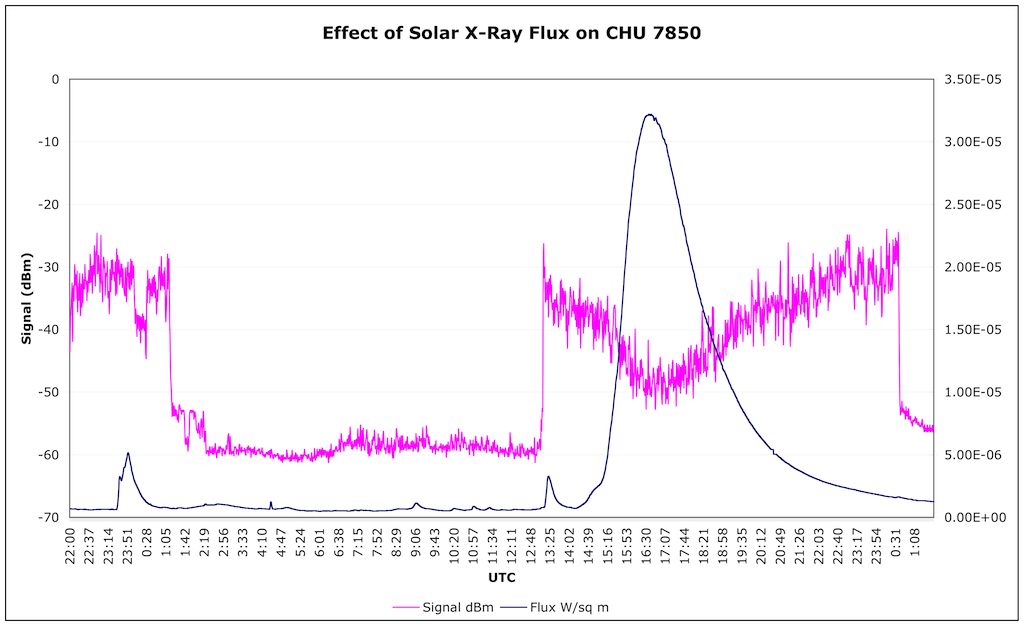Here’s a graph of the signal strength of CHU 7850 kHz (the Canadian time station) recorded from 2200 UTC on January 18, 2012 to 0100 UTC on January 20, 2012, the signal strength is the pink line, and is in dBm. Also shown on the graph is the solar x-ray flux level, as measured by the GOES 15 weather satellite (click on the graph for a larger image):

The recording was made with an SDR-14 set to record a 5 kHz bandwidth (8137 Hz sampling rate) centered on 7850 kHz. This was AM demodulated with the IF filter set to cover 7849.7 to 7852.5 kHz, covering the carrier as well as much of the modulated signal. CHU transmits a carrier and upper side band, with 10 kW of power. The displayed dBm readings are too high by 24 dB, due to the IF gain setting on the SDR-14. I’ll need to correct for that with future recordings. But the relative changes are valid.
We can observe a few things here. First, there are three sudden changes in signal strength:
At 0114 UTC, the signal suddenly dropped by about 25 dB, this is when the band went long. It then further dropped another 6 dB or so.
At 1312 UTC, the signal suddenly came back up, this is when F layer ionization was strong enough again for reception of CHU via NVIS.
At 0038 UTC, the signal dropped again when the band went long. Note that this occurred at a different time than the night before.
For reference, CHU is about 550 km from my location.
The big event on the 19th was the solar flare. It peaked at a level of M3.2, and was a very long duration flare, it stayed at M levels from about 1500 to 1930 UTC. You can see the effects on CHU, the signal dropped about 2 S units (12 dB). The effects on CHU’s 90 meter frequency of 3330 kHz were even more dramatic, I tried tuning in, and it was completely gone. Normally it is S9 or better during the daytime in the winter.
The attenuation was due to the x-rays from the flare increasing the ionization of the D layer of the ionosphere. The D layer does not contribute to propagation, rather it attenuates radio waves. So a stronger D layer means weaker signals, and the effect is more pronounced at lower frequencies.
You’ll notice a dip in the signal around 2300 UTC on the first day, and a small solar flare about the same time. I believe this is a coincidence, not due to the flare. The decrease in signal is too sudden, and the flare was not that large. I quickly put up a special dipole for this test, and it may have some issues. We had some wind that day, perhaps there was an intermittent contact.
While we didn’t have any flares overnight, if we had, there would not have been an affect on the signal, as they only affect the part of the Earth in sunlight, and this path was entirely in the dark side of the Earth.

Its curious how on the first night, the band went long in what looks like two phases, as you pointed out. However, on the second night, from the limited amount of recording shown, it looks like one one dramatic phase when the band went long. Again, perhaps wind on your new dipole accounts for this, or is something else going on?
Unfortunately I cut off the recording just after CHU went long. Looking at the graph, it appears that the signal level was still going down, similar to the first night (which also had some sudden jumps in the signal level).
If I get the chance, I’ll run some more tests on 7850, to see how repeatable the pattern is.
Yeah that would be really interesting.
Awesome thats the post I’ve been wtaiing for! I really got get a license. I’m thinking this winter will be perfect time since I won’t be able to spend all my time outdoors. I did pick up a PRO-97 scanner a couple of weeks ago and I still have a HTX-404 I bought (never transmit of course) in Rockwall